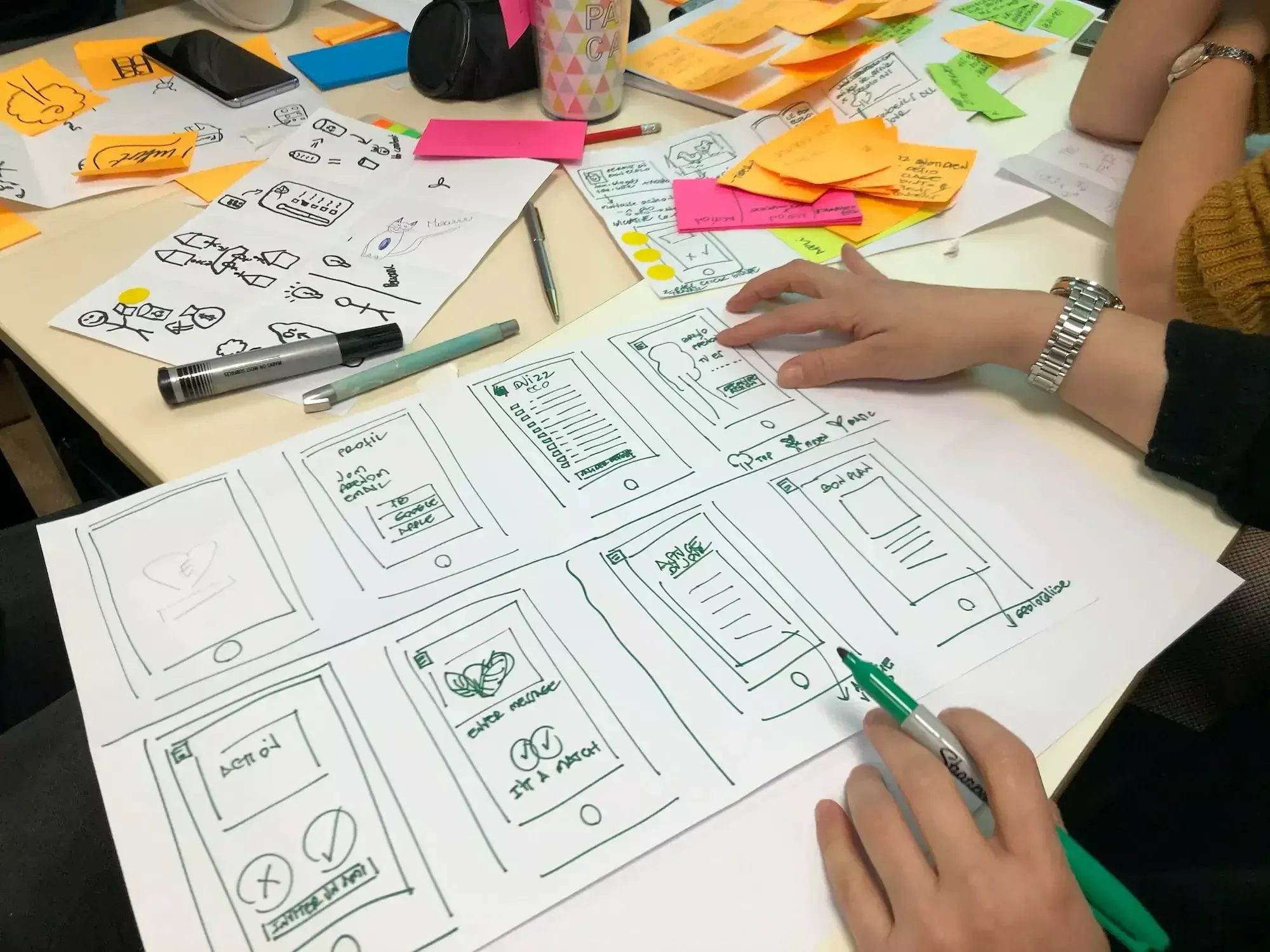Mobile Development In 6 Steps At MVST

With the growing number of mobile users worldwide, mobile apps have become a significant platform for companies to engage with their customers. However, developing mobile apps can be a complex and challenging task, and without a clear process in place, it can quickly become overwhelming.
A mobile application development process is a set of guidelines, best practices, and procedures that a development team follows to create a mobile app. This process covers all aspects of app development, from ideation to design, development, testing, deployment, and maintenance. Having a defined process is essential for the success of mobile app projects, as it helps ensure that the development team delivers a quality product that meets the project's objectives, within the specified timeline and budget.
A well-defined mobile app development process provides a framework for developers to follow and helps to ensure that all stakeholders are on the same page throughout the development cycle. This can prevent misunderstandings, delays, and costly mistakes. It also allows developers to prioritize tasks, manage resources effectively, and identify potential roadblocks before they become major issues.
The Body of a Mobile App
The structure of a mobile app is critical to its functionality and success. It comprises various components, including the client, backend, database, and infrastructure. Each of these components plays a crucial role in ensuring that the app runs seamlessly and provides an excellent user experience.
- The client is the face of the mobile app. It is the part of the app that the user interacts with and includes everything from the app's activities to the events that take place within the app. The client is responsible for presenting the app's interface, collecting user input, and displaying the app's output.
- The backend is the heart of the mobile app. It is the secure and sound server-side of the mobile application that handles all the data processing and logic of the app. It is responsible for processing user requests, authenticating users, and managing the app's state. The backend ensures that the app is scalable, reliable, and secure.
- The database is the brain of the mobile app. It provides reliable storage for all the relevant data needed by the app. This includes user data, preferences, settings, and app data. The database ensures that data is stored securely, accessed efficiently, and is available for use when needed.
- Finally, infrastructure is the place of the mobile app. It provides a flexible and scalable environment for the app through cloud hosting. The infrastructure ensures that the app is available 24/7, and users can access it from anywhere. Cloud hosting provides scalability, reliability, and security to the app and ensures that it can handle large volumes of users without any downtime.
A Step-by-Step Guide: 6 Steps to Success
So, let’s finally take a look at our mobile development process at MVST.
Step 1: Product Definition
Product Definition is an important step in the mobile development project, where product management plays a crucial role. This phase involves a deep understanding of the client's app ideas and the app’s functionality required.
To start, MVSTs project management conduct a workshop with the client. This is a collaborative session where the team creates an app development strategy.
Information gathering between the product managers and the client is key, and Slack is an effective tool for this. Slack allows for real-time communication and collaboration, making it easier for the team to stay informed and up-to-date on the client's needs and expectations.

To ensure that all ideas, visions, plans, and next steps are recorded and organized, our product management team uses Notion. Notion is a powerful organizational tool that allows the team to keep all project information in one place, making it easy to access and review at any time. This helps to ensure that all parties are on the same page and that nothing is forgotten or overlooked.
In conclusion, product definition requires collaboration between MVSTs product managers and the client. The use of workshops, Slack, and Notion helps to ensure that the client's vision and needs are understood and that all ideas, plans, and next steps are recorded and organized for future reference.
Step 2: Product Architecture and User Flows
In this stage, product managers at MVST focus on creating a solid foundation for the project by establishing the product architecture and defining user flows.
To start, the team creates first wireframes and an information architecture in Figma, which is MVSTs favorite design tool that allows the team to visualize the user experience and layout of the mobile application. The wireframes help to provide a clear understanding of the structure of the mobile app and the relationships between different pages and elements.
Next, the product managers decide on the roadmap and milestones for the project. This involves setting clear goals and deadlines for each phase of the project and determining the tasks required to reach those milestones. The roadmap helps to ensure that the project stays on track and that all stakeholders are aware of the progress and status.
To track and manage the project, the product management team uses Jira, which is an app that allows teams to track issues, manage projects, and automate workflows. Jira helps to ensure that all tasks are completed on time and that the team is aware of any issues that need to be addressed.
By using these tools, the product management team can ensure that all parties are informed and up-to-date on the project status and that any issues are quickly resolved.
Step 3: Product Design
This is the step where the product design team works to create a visually appealing and user-friendly mobile app design.
Weekly meetings with the client are held to showcase the design and receive feedback via Figma. This allows our product managers to stay in close communication with the client and ensure that the design is on track to meet their expectations.
MVST is a design-driven software development studio. And since design is such a leading part in our projects we put our hearts and souls into the mobile design step.
The design process includes the following steps:
1. Understand & Research:
The first step is to understand the customer's needs and formulate the problem they have. Our User Interface design team conducts research to gain a deeper understanding of the problem and the customer's needs. Then it looks at all the competitors, screens dribbble and other sources for ideas and inspirations, and conducts interviews with all people in the customer's company who may be needed.
2. UX Design:
The next step is to define the user flows and functions. MVST designers focus on creating a seamless user experience, ensuring that the design elements are easy to navigate and use.
3. Prototype:
They then test the flows and functions of the frameworks and conduct user interviews and user testing to gather feedback and make any necessary adjustments.
4. Design:
The design phase includes creating a moodboard and inspiration, plugins, selectings fonts, exploring and conceptualizing the graphic design, and creating the UI design and style guide. MVSTs mockups have the highest UI/UX qualities.

5. Interactions & Animations:
MVST then designs interactions and animations to enhance the user experience.
6. Handoff:
Finally, our designers prepare for the handoff of their templates to development, present the design to the team, and hand over the design files for the mobile app.
Step 4: Development (Sprints)
Development is a crucial step, because that's where the developers work to bring the design to life and build a functional mobile app. In this stage, the developers focus on writing code to implement the user stories and ensure that the application meets the requirements and vision of the client.
Developers at MVST follow a series of steps to ensure that the development process is of the highest quality:
1. Check the design and user flows for each story:
Here our front-end developers review the design and user flows for each story to ensure that they understand the requirements and vision of the client.
2. Code the user story:
MVST developers then write the code to implement the user story, following best practices for coding and ensuring that the code is efficient and maintainable. At MVST the developers mainly work with HTML, Javascript, CSS and other popular programming languages. When it comes to creating mobile apps, we use APIs to connect the apps to back-end systems and services, allowing for real-time data exchange and seamless user experiences.
3. Check for edge cases:
We test the code for edge cases, where the user may interact with the mobile application in unexpected ways, to ensure that the code is robust and handles all scenarios.
4. Write tests:
Then our backend developers write tests to prevent functionalities from breaking, especially with business logic, to ensure that the code is reliable and that future changes do not cause unintended consequences. Usually our developers create MVPs (minimum viable product) to test the most important functions of ios apps and android apps. Performance testing and mobile app testing is an integral part of our process to ensure a nice experience for end-users on their smartphones.

5. Code reviewing:
The full-stack developers at MVST review each other's code to ensure that it is of high quality and that all best practices are followed.
6. Automatic deployment:
Finally, the latest version of the code is automatically deployed, allowing the testers to access the latest version of the mobile app, take a look at the all over compatibility and provide feedback.
The development life cycle is an iterative one, following the agile methodology loop, where the developers continuously refine the code and make improvements based on feedback.
At MVST, we utilize both Flutter and React Native to build mobile apps that work seamlessly across multiple operating systems, including iOS and Android. These frameworks allow us to create high-quality, performant, and visually stunning apps that meet our clients' specific needs and requirements. With our expertise in both Flutter and React Native, we're able to provide our clients with the best possible cross-platform solution for their needs.
Product management is responsible for organizing and structuring bi-weekly sprints and keeping track of the development stage and sprint goals. They ensure that the development process is aligned with the client's vision and that the project is on track to meet its goals.
When all the needed information about the project is gathered, our marketing team starts to write content and syncs it with the app layout. They create the wording for a nice and clean mobile app to hit the SEO ranking scores.
Step 5: Quality Assurance
Quality assurance is an indispensable step in the mobile development process. Here MVST ensures that the mobile app meets the client's requirements and expectations, and that the user experience is of the highest quality.
Our product managers play a key role in the quality assurance process, by testing, and improving the mobile app. They conduct weekly check-ups with the client to gather feedback and ensure that the current process is aligned with the client's vision. This ongoing feedback loop allows the team to continuously refine the apps and ensure that it meets the client's expectations.
MVST developers are also responsible for ensuring that everything is working and flowing the way it should. They follow the steps outlined in the development section to ensure that the code is robust and reliable, and that the user experience is of the highest quality.
In conclusion, the quality assurance process involves ongoing testing and improvement, with the goal of delivering a successful mobile app that has a nice look and feel. At the very end, we release the final product at the apple app store, google play store etc.
Step 6: Post-release Support
Post-release support is an extremely important part of the whole process, as it ensures that the app continues to work as it should and add new features after launch.
Our developers ensure that the technology stack for development, including the frontend and backend, is up-to-date and functioning properly. They are responsible for troubleshooting and fixing any technical issues that arise after launch, and for updating the apps as needed to keep it running smoothly.
MVST product managers are responsible for handing over the product to the client, along with all relevant documentation. This includes technical specifications, user manuals, and any other information that the client may need to use and maintain the app features effectively.

Our marketing team also plays a role in post-release support, by promoting the project on social media and MVST’s website. They may also reach out to clients for feedback and use the feedback to improve the app and enhance the user experience. They always got their eyes on the target audience and make sure to reach them using SEO (search engine optimization) tools, content management systems and e-commerce. Additionally, marketing always writes showcases for our website and social media to demonstrate the success of the project and highlight its unique features and capabilities.
In conclusion, post-release support is a critical part of the mobile development process, where developers, product management, and marketing teams all work together to ensure that the mobile app is successful and provides value to the client for years to come.
Why Do Startups And Business Owners Even Need Mobile Apps?
Mobile apps have become increasingly important for startups and business owners in recent years. Here are some reasons why:
- Increased customer engagement: Mobile apps provide a direct and personalized way to engage with customers. They allow businesses to send push notifications, provide personalized content and promotions, and offer a streamlined checkout process. This increased engagement can lead to greater customer loyalty and retention.
- Enhanced brand recognition: Mobile apps provide businesses with a platform to showcase their brand and build brand recognition. They offer a unique and immersive experience that can help businesses differentiate themselves from their competitors.
- Improved customer experience: Mobile apps can help businesses provide a seamless and convenient customer experience. They allow customers to easily access products and services from their mobile devices, and offer features such as real-time tracking, one-click checkout, and easy returns.

- Increased sales and revenue: Mobile apps can help businesses increase sales and revenue by providing a direct and convenient way for customers to purchase products and services. They also offer opportunities for upselling and cross-selling, as well as the ability to offer personalized promotions and discounts.
- Competitive advantage: Mobile apps have become increasingly popular among consumers, and businesses that do not have a mobile app may fall behind their competitors. Having a mobile app can give businesses a competitive advantage by providing a unique and personalized way to engage with customers.
What Makes Apps Built by MVST Worthy
At MVST, our goal in creating mobile apps is to deliver products that meet our principles to offer the best experience possible. Our products are scalable and flexible, designed to grow with your business model and adapt to your changing requirements and ideas. We want our applications to be as sustainable and stable as possible, providing you with a product that can last for years to come.
- We understand the importance of maintainability, and that's why our products are easy to maintain and expand. We want you to enjoy your products for as long as possible, and we are always ready to help you with maintenance and any necessary updates.
- To provide you with the best experience, we only use the most modern, stable, and outstanding technologies available. Technology is the backbone of your product, and we are committed to staying up-to-date with the latest innovations and trends within the market.
- We prioritize the security of your data and your customers' data, and we only work with technologies and procedures that comply with international security standards. Safety always comes first, and we want you to have peace of mind when it comes to the security of your product.
- Finally, we understand the importance of GDPR compliance, especially when it comes to personal data. Our products comply with GDPR standards, and we take extreme caution when it comes to the protection of your and your customers' personal data.

